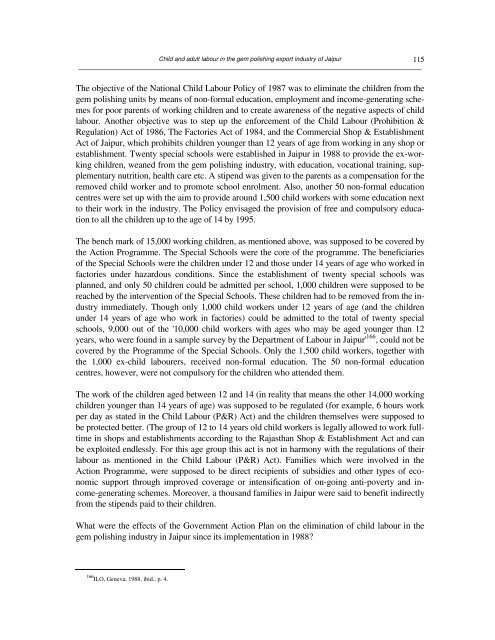You also want an ePaper? Increase the reach of your titles
YUMPU automatically turns print PDFs into web optimized ePapers that Google loves.
<strong>Child</strong> <strong>and</strong> <strong>adult</strong> <strong>labour</strong> <strong>in</strong> <strong>the</strong> <strong>gem</strong> polish<strong>in</strong>g <strong>export</strong> <strong>in</strong>dustry <strong>of</strong> Jaipur<br />
──────────────────────────────────────────────────────────────────────────────────────────────<br />
The objective <strong>of</strong> <strong>the</strong> National <strong>Child</strong> Labour Policy <strong>of</strong> 1987 was to elim<strong>in</strong>ate <strong>the</strong> children from <strong>the</strong><br />
<strong>gem</strong> polish<strong>in</strong>g units by means <strong>of</strong> non-formal education, employment <strong>and</strong> <strong>in</strong>come-generat<strong>in</strong>g schemes<br />
for poor parents <strong>of</strong> work<strong>in</strong>g children <strong>and</strong> to create awareness <strong>of</strong> <strong>the</strong> negative aspects <strong>of</strong> child<br />
<strong>labour</strong>. Ano<strong>the</strong>r objective was to step up <strong>the</strong> enforcement <strong>of</strong> <strong>the</strong> <strong>Child</strong> Labour (Prohibition &<br />
Regulation) Act <strong>of</strong> 1986, The Factories Act <strong>of</strong> 1984, <strong>and</strong> <strong>the</strong> Commercial Shop & Establishment<br />
Act <strong>of</strong> Jaipur, which prohibits children younger than 12 years <strong>of</strong> age from work<strong>in</strong>g <strong>in</strong> any shop or<br />
establishment. Twenty special schools were established <strong>in</strong> Jaipur <strong>in</strong> 1988 to provide <strong>the</strong> ex-work<strong>in</strong>g<br />
children, weaned from <strong>the</strong> <strong>gem</strong> polish<strong>in</strong>g <strong>in</strong>dustry, with education, vocational tra<strong>in</strong><strong>in</strong>g, supplementary<br />
nutrition, health care etc. A stipend was given to <strong>the</strong> parents as a compensation for <strong>the</strong><br />
removed child worker <strong>and</strong> to promote school enrolment. Also, ano<strong>the</strong>r 50 non-formal education<br />
centres were set up with <strong>the</strong> aim to provide around 1,500 child workers with some education next<br />
to <strong>the</strong>ir work <strong>in</strong> <strong>the</strong> <strong>in</strong>dustry. The Policy envisaged <strong>the</strong> provision <strong>of</strong> free <strong>and</strong> compulsory education<br />
to all <strong>the</strong> children up to <strong>the</strong> age <strong>of</strong> 14 by 1995.<br />
The bench mark <strong>of</strong> 15,000 work<strong>in</strong>g children, as mentioned above, was supposed to be covered by<br />
<strong>the</strong> Action Programme. The Special Schools were <strong>the</strong> core <strong>of</strong> <strong>the</strong> programme. The beneficiaries<br />
<strong>of</strong> <strong>the</strong> Special Schools were <strong>the</strong> children under 12 <strong>and</strong> those under 14 years <strong>of</strong> age who worked <strong>in</strong><br />
factories under hazardous conditions. S<strong>in</strong>ce <strong>the</strong> establishment <strong>of</strong> twenty special schools was<br />
planned, <strong>and</strong> only 50 children could be admitted per school, 1,000 children were supposed to be<br />
reached by <strong>the</strong> <strong>in</strong>tervention <strong>of</strong> <strong>the</strong> Special Schools. These children had to be removed from <strong>the</strong> <strong>in</strong>dustry<br />
immediately. Though only 1,000 child workers under 12 years <strong>of</strong> age (<strong>and</strong> <strong>the</strong> children<br />
under 14 years <strong>of</strong> age who work <strong>in</strong> factories) could be admitted to <strong>the</strong> total <strong>of</strong> twenty special<br />
schools, 9,000 out <strong>of</strong> <strong>the</strong> '10,000 child workers with ages who may be aged younger than 12<br />
years, who were found <strong>in</strong> a sample survey by <strong>the</strong> Department <strong>of</strong> Labour <strong>in</strong> Jaipur' 166 , could not be<br />
covered by <strong>the</strong> Programme <strong>of</strong> <strong>the</strong> Special Schools. Only <strong>the</strong> 1,500 child workers, toge<strong>the</strong>r with<br />
<strong>the</strong> 1,000 ex-child <strong>labour</strong>ers, received non-formal education. The 50 non-formal education<br />
centres, however, were not compulsory for <strong>the</strong> children who attended <strong>the</strong>m.<br />
The work <strong>of</strong> <strong>the</strong> children aged between 12 <strong>and</strong> 14 (<strong>in</strong> reality that means <strong>the</strong> o<strong>the</strong>r 14,000 work<strong>in</strong>g<br />
children younger than 14 years <strong>of</strong> age) was supposed to be regulated (for example, 6 hours work<br />
per day as stated <strong>in</strong> <strong>the</strong> <strong>Child</strong> Labour (P&R) Act) <strong>and</strong> <strong>the</strong> children <strong>the</strong>mselves were supposed to<br />
be protected better. (The group <strong>of</strong> 12 to 14 years old child workers is legally allowed to work fulltime<br />
<strong>in</strong> shops <strong>and</strong> establishments accord<strong>in</strong>g to <strong>the</strong> Rajasthan Shop & Establishment Act <strong>and</strong> can<br />
be exploited endlessly. For this age group this act is not <strong>in</strong> harmony with <strong>the</strong> regulations <strong>of</strong> <strong>the</strong>ir<br />
<strong>labour</strong> as mentioned <strong>in</strong> <strong>the</strong> <strong>Child</strong> Labour (P&R) Act). Families which were <strong>in</strong>volved <strong>in</strong> <strong>the</strong><br />
Action Programme, were supposed to be direct recipients <strong>of</strong> subsidies <strong>and</strong> o<strong>the</strong>r types <strong>of</strong> economic<br />
support through improved coverage or <strong>in</strong>tensification <strong>of</strong> on-go<strong>in</strong>g anti-poverty <strong>and</strong> <strong>in</strong>come-generat<strong>in</strong>g<br />
schemes. Moreover, a thous<strong>and</strong> families <strong>in</strong> Jaipur were said to benefit <strong>in</strong>directly<br />
from <strong>the</strong> stipends paid to <strong>the</strong>ir children.<br />
What were <strong>the</strong> effects <strong>of</strong> <strong>the</strong> Government Action Plan on <strong>the</strong> elim<strong>in</strong>ation <strong>of</strong> child <strong>labour</strong> <strong>in</strong> <strong>the</strong><br />
<strong>gem</strong> polish<strong>in</strong>g <strong>in</strong>dustry <strong>in</strong> Jaipur s<strong>in</strong>ce its implementation <strong>in</strong> 1988?<br />
115<br />
166 ILO, Geneva, 1988, ibid., p. 4.


















